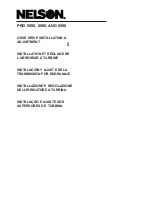
© National Instruments Corporation
|
2-11
In NI-DAQmx, enable hardware timing with the Sample Clock instance of the DAQmx Timing
function or VI or by setting the
Sample Timing Type
property to Sample Clock. If you do
neither of these things, or you set the
Sample Timing Type
attribute/property to On Demand,
you are selecting software timing.
ADC Timing Modes
Although the timing engine on the NI PXIe-4357 supports sampling the channels at nearly any
sample rate requested up to 100 S/s, the five internal ADCs are capable of acquiring data at only
nine different discrete rates that are defined by timing modes 1 through 9 in NI-DAQmx. Timing
mode 1 (high resolution) samples signals at the slowest rate, but has the lowest noise and the
highest 50/60 Hz power line rejection. By default, if you are using on-demand (or software)
timing, timing mode 1 is enabled regardless of the channel count. Timing mode 9 (high speed)
samples signals at the fastest rate, but has the highest level of noise and does not provide
50/60 Hz power line filtering. The noise and digital filter bandwidth change incrementally for
each intermediate timing mode. Additionally, timing mode 4 offers 50/60 Hz noise rejection and
timing mode 5 offers 60 Hz noise rejection only. Refer to the
NI PXIe-4357 Specifications
document for details about the digital filter bandwidth and rejection for different timing modes.
When the
ADC Timing Mode
property is not explicitly set, NI-DAQmx automatically selects
the lowest possible ADC timing mode for the selected sample rate and number of channels,
which results in the best accuracy. Table 2-4 shows the ADC timing mode NI-DAQmx uses for
best accuracy, depending on sample rate and number of channels.
Since the NI PXIe-4357 has a multiplexed architecture, there is a timing skew between channels
in a scanlist. A scanlist is an ordered list of channels to be sampled. The skew between channels
is based on how long it takes the ADC to convert signals. Timing mode 9 has the least amount
of skew between channels.










































